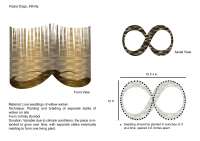2 site-specific environmental art proposals in wicker: Infinity and Tipi
I am proposing two different projects for and international residency in 2010.
The first piece, entitled Infinity, will be a permanent work installed and braided on site by local craftsmen and myself, over the course of 8 days. The work will be created entirely out of living wicker seedlings (essentially willow seedlings that are cropped rather than allowed to grow freely).
In the northern countries, wicker is usually planted in the Spring, however hopefully the milder climate of Azores will allow for planting in the fall. The work will take the form of a large mathematical symbol for infinity (3 meters long, 5 meters wide, 1.5-3 meters tall). The dimensions of the piece can be modified in consultation with Azores staff. Over time, the braiding technique employed on the piece will cause the separate stalks of wicker to grow together as one plant. The height of the piece will increase over time as the strands of wicker grow. The work will need to be located in a wetland where the wicker will have enough water to grow over time. The work will also require maintenance from time to time (replacement of any dry branches with new strands of wicker), however the frequency of maintenance will be determined by local environmental conditions.
The second, temporary site-specific installation is called Tipi. This piece will be part of a larger series of sculptures that I have been working on, across Europe, over the last 5 years. Each work in the series depicts a larger that life detail of the human body, woven out of wicker and attached to the ground or floating on water. A Tipi is a tent-like structure used as a mobile form of shelter by many Native American tribes in the past. By making a tipi out of the forms of human hands, I am hoping to create a metaphor for the human body as a home.
The sculpture will measure 4 meters wide x 1,5 meters deep by 2 meters tall at it’s highest point. Depending on the size of the available wicker, the piece may require a steel armature. In this case, I will need 20 steel poles (0,5 cm diameter x 2-3 m. long) as well as a welding assistant to help me put in place a basic steel armature for the structure. The piece will then be woven atop the armature once it is in place.
The art work will require about 50kg of thinner 1,20-1,80 m. long wicker for horizontal weaving and more detailed sections and 20 kg of thicker 2 m. - 2,20 m. long wicker for vertical support and base weaving. The piece can be on display outdoors from 3 months to over a year depending on local weather conditions.
2 site-specific environmental art proposals in wicker: Infinity and Tipi
I am proposing two different projects for and international residency in 2010.
The first piece, entitled Infinity, will be a permanent work installed and braided on site by local craftsmen and myself, over the course of 8 days. The work will be created entirely out of living wicker seedlings (essentially willow seedlings that are cropped rather than allowed to grow freely).
In the northern countries, wicker is usually planted in the Spring, however hopefully the milder climate of Azores will allow for planting in the fall. The work will take the form of a large mathematical symbol for infinity (3 meters long, 5 meters wide, 1.5-3 meters tall). The dimensions of the piece can be modified in consultation with Azores staff. Over time, the braiding technique employed on the piece will cause the separate stalks of wicker to grow together as one plant. The height of the piece will increase over time as the strands of wicker grow. The work will need to be located in a wetland where the wicker will have enough water to grow over time. The work will also require maintenance from time to time (replacement of any dry branches with new strands of wicker), however the frequency of maintenance will be determined by local environmental conditions.
The second, temporary site-specific installation is called Tipi. This piece will be part of a larger series of sculptures that I have been working on, across Europe, over the last 5 years. Each work in the series depicts a larger that life detail of the human body, woven out of wicker and attached to the ground or floating on water. A Tipi is a tent-like structure used as a mobile form of shelter by many Native American tribes in the past. By making a tipi out of the forms of human hands, I am hoping to create a metaphor for the human body as a home.
The sculpture will measure 4 meters wide x 1,5 meters deep by 2 meters tall at it’s highest point. Depending on the size of the available wicker, the piece may require a steel armature. In this case, I will need 20 steel poles (0,5 cm diameter x 2-3 m. long) as well as a welding assistant to help me put in place a basic steel armature for the structure. The piece will then be woven atop the armature once it is in place.
The art work will require about 50kg of thinner 1,20-1,80 m. long wicker for horizontal weaving and more detailed sections and 20 kg of thicker 2 m. - 2,20 m. long wicker for vertical support and base weaving. The piece can be on display outdoors from 3 months to over a year depending on local weather conditions.

